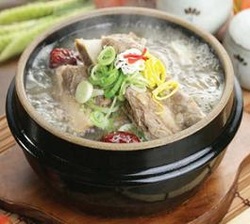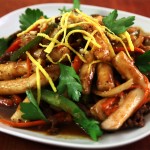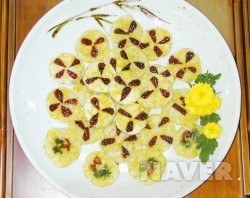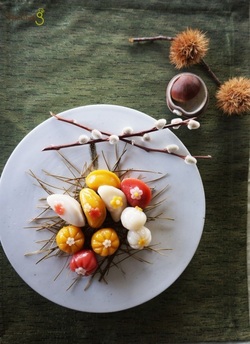 Galbitang is a soup-based dish made primarily from beef short ribs and it is one of most commonly found soups in Korean cuisine. It’s similar to sollongtang where clear and hearty soup is made by slowly simmering galbi in water for a long period of time and is eaten as a meal. Short ribs along with daikon radish, onions, garlic, and other ingredients are all boiled together for approximately five hours until most of the fat is drained out and the meat becomes very tender. A spicy version of this dish called maeun galbitang (spicy short rib beef soup) is available by adding gochujang and gochugaru.
Great care and attentiveness during its cooking process is needed when preparing this dish since soup should be chilled so that fat floating on the surface can be removed repeatedly for optimal taste. The ribs are chopped into 1-2 inches in length and slits are sometimes made in the top of the inner bones before the ribs are cut to make the flesh separate easily from the prepared beef ribs. The seasoned ribs and sliced daikon are again put into the pot along with vermicelli noodles which are then simmered once more. Finally, each serving bowls are seasoned with minced scallions, black pepper powder and salt to meet individual taste buds.
 Hello!
Today, I will introduce Korean traditional food, Gungjungddeokbokki, or Royal Court Rice Pasta. Most foreigner know about Korean Ddeokbokki, which has a hot taste. But, Gungjungddeokbokki is a non-spicy dish and calls for a variety of colorful vegetables, mushrooms, and marinated beef.
Gungjungddeokbokki is actually the original ddeokbokki and is very different than the more well-known red, spicy version. It has a lot more ingredients, for one, and it’s stir fried and it’s made with soy sauce. It was originally served in the royal court during the Choson dynasty (1392–1910) and was considered to be a very fancy haute cuisine. This was before hot peppers were introduced or popular in Korea, so it isn’t spicy at all.
After gochujang was developed, a lot of people added it to Gungjungddeokbokki to make it spicy. But after the Korean war (1950-1953) a small store in Sindang-dong Seoul got famous by selling a cheap snack of spicy ddeokbokki made with flour-based rice cakes. This eventually became the spicy ddeokbokki that’s so popular today.
 Let me introduce 2nd traditional food of autumn, Guk hwa jeon. Guk haw jeon is kind of pancake made of chrysanthemum. Our ancestors made Guk haw jeon and Guk haw alcoholic drink, and played with mountain or the valley in the ninth day of the ninth month of the lunar calendar(Joong yang zeol). Why did they go to mountain? It is because of an old story. Once upon a time, there was a person who had supernatural powers. One day, He went to one town, and told people of the town that they must climb a mountain having chrysanthemum in the ninth day of the ninth month of the lunar calendar, because the town will meet with a misfortune in that day. So they climbed the mountain, played, and drank Guk haw alcoholic drink for 2 days. And then, they go back to the town, all of livestock are dead. After that time, people observe custom climbing mountain in the ninth day of the ninth month of the lunar calendar. And people eat Guk hwa jeon, because it is the national flower of autumn and encourage a youthful enthusiasm specially and it gave and excels even in aging prevention and high blood-pressure, tubular
arteriosclerosis, headache, the cold and dizziness the effect which plentifully even with the medicine stuffs and it kept it was used.
Now, Let’s make Guk hwa jeon! The ingredients of Guk hwa jeon are 4 cups of glutinous rice flour, water, chrysanthemum, honey, olive oil. First, detach floral leaf from flower and remove water. Next, knead the rice flour putting hot water gradually. And, take of rice flour dough a little, and make it flatly. After that, oil the frying pan, and broil the dough pressing it flatly. And then, put floral leaf of chrysanthemum on the dough when it goes translucent. Finally, cover honey on the dough. Then, all is finished!
How about trying Guk hwa jeon in these days that chilly, and windy?
 There are many delicious foods in Korea. So our Yummy Yummy team want to introduce Korean traditional foods to professor and other many foreigner. Above all, in fall that is productive season, there are many foods to enjoy. Thus, I’m going to introduce foods of fall.
First food is “Songpyeon.” Songpyeon is rice cake prepared for Chuseok that is Korea’s representive national holiday. Many families get together and make them as they prepare for Chuseok. They are half-moon shaped. Why are they half-moon shaped? Two Songpyeons are put together, then they are full-moon shaped. According, It means community spirit. But, Songpyeon has many shape - spherical shape, flatted shape, crushed shape, and even flowered shape.
Now, Let’s make Songpyeon! In advance, we need some meterials: rice powder, beans, sesame oil(it is scented aromatic smell), salt, pine needles. After all meterials are prepared, Boil the water and pour it in to rice powder, and cover it with wet cloth for half an hour. Pour beans into boiled water and pour salt into water and boil. Take of rice powder dough a little, dig the dough and put beans into dough. Make space circlewise in little dough and put Songpyeonso that is sweety paste made powdered sesame mixed together honey. Spread the cloth and put Songpyeon into the steamer, and pour pine needles into the steamer. Steam Songpyeon for 20 minutes. Spill sesame oil and salt on Songpyeon. Then, apptetizing Songpyeon is made.
In the old days, people ate Songpyeon in special day, but nowdays, people ate them ordinary day too. Songpyeon is yummy and usually sweety food. Enjoy delicious Songpyeon next Chuseok!
|




 RSS Feed
RSS Feed